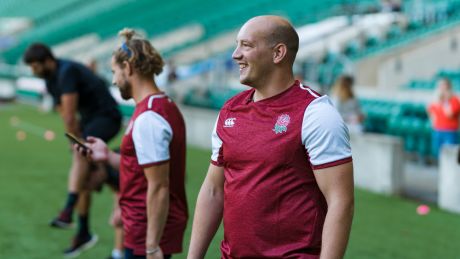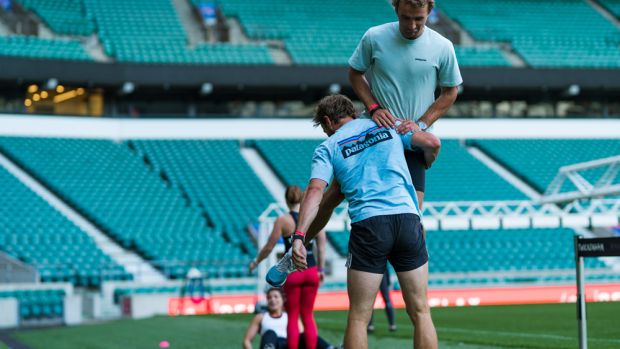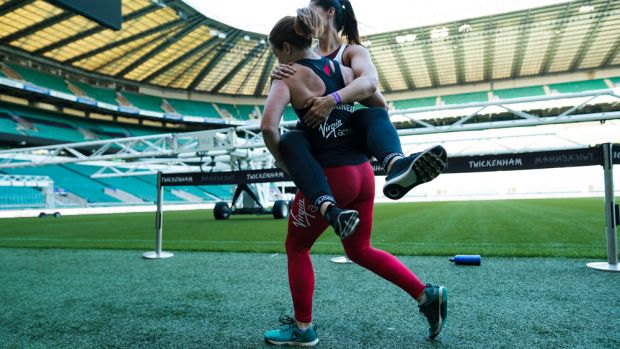Find A Friend To Tackle This Rugby Strength And Conditioning Workout
Mark the Rugby World Cup by getting sweaty

We’ll start by saying you should be really quite well acquainted with the partner you choose for this two-person workout, because you’re going to be getting up close and personal with them for large parts of it. We’ll also say you should pick someone of a similar build to you, because there’s a lot of carrying involved, so opting for your biggest friend might prove unwise.
The workout has been designed by strength and conditioning coach Tom Farrow for the England Sevens rugby team and can be done without any equipment at all – when you’re carrying around your partner there’s little need to add weights to the equation.
Warm-Up
“The main focus here is to raise the heart rate, mobilise your joints and get your muscles warming up before the higher intensity exercises,” says Farrow.
1 Speed drills
“Using moves such as high knee drives and side shuffles, perform a few drills to warm up the lower-body muscles while testing your co-ordination, and mobilising the ankles, knees and hips,” says Farrow.
2 Knee, hip and shoulder taps
“Work with your partner and aim to tap them on their knees, shoulders, or hips while avoiding being tapped yourself,” says Farrow. “This drill is really good to test your reflexes and speed while building team spirit.”
3 Bear crawl tag
“Chase your partner while both of you are bear crawling,” says Farrow. “Bear crawls are an amazing exercise for full-body mobilisation as you are working and strengthening every joint in your body, which helps with injury prevention as it allows for a better range of movement with less strain on the joints.”
4 Jump circuit
“The final part of the warm-up is where you start to pick up the pace and get the muscles and heart working a bit harder,” says Farrow. “Do 12 squat jumps, 12 skater leaps and 12 jump lunges. As it is still the warm-up, make it an easy effort to get the joints used to the impact before it gets more intense.”
Get the Coach Newsletter
Sign up for workout ideas, training advice, reviews of the latest gear and more.
Partner Circuit
“This is where it starts to get intense,” says Farrow. “Grab your partner and start going through drills that will build your teamwork, strength and cardio fitness. You only have 20 seconds for each exercise, and you want to get as many reps as you can in the time, meaning you are going to work hard!”
Do two rounds of the following circuit. With the partner exercises switch positions for the second circuit.
1 Sit-up to pick-up
Time 20sec Rest 10sec
“Start lying on your back, then roll up to standing and lift your partner off the ground,” says Farrow. “This drill is all about power – you need to build momentum through your core to launch yourself onto your feet from your back, before driving up through your legs when lifting your partner.”
2 Over back, through legs
Time 20sec Rest 10sec
“Again this is about co-ordination and speed,” says Farrow. “One person starts by jumping over their partner’s back [as if you’re playing leapfrog] before turning around and crawling through their legs. This one is really going to get your heart rate up and get your whole body burning if you push yourself.”
3 Sprawl roll jump
Time 20sec Rest 10sec
“Start standing next to your partner,” says Farrow. “You both drop to the ground, roll in one direction, then stand up and jump up. Then repeat, going the other way. This, again, is going to get every muscle in your body working, while still needing a degree of co-ordination as you move in time with your partner.”
4 Press-up/high plank
Time 20sec Rest 10sec
“One person holds a high plank with straight arms while the other person places their hands on the first person’s back with their feet on the ground and does press-ups,” says Farrow. “This one is predominantly an upper-body exercise, working the core hard via the high plank with the added weight of your partner on top, while the press-ups will continue to engage the core while working the chest and arms.”

Carry Circuit

“This circuit mainly works your lower body, while also challenging your grip strength,” says Farrow. “You go through a series of carries running about 20m in one direction, then change who carries whom and run back.”
Do the following round of carries three times.
1 Wiggle
“Face your partner and lift them from the hips, holding them in front of you,’ says Farrow. “As you are running the partner being carried has to wiggle as much as they can to try and get out of it. For the person lifting them this will further challenge their grip as they try to hold them, as well as their core as they stabilise their own torso to keep moving forwards.”
2 Over-the-shoulder carry
“Lift your partner over one shoulder and run as fast as you can to the end of 20m,” says Farrow.
3 Baby carry
“For the final carry you are holding your partner on your side with their legs wrapped around your hips,” says Farrow. “This offers the same benefits as the above two carries with the addition of challenging the sides of your core – the obliques – as you try to hold yourself upright with the weight of your partner on one side.”
Wrestle Run
“Wrap one arm over your partner’s shoulder and the other arm under the other shoulder, while your partner does the same on the opposite side,” says Farrow. “Once in position you have 30 seconds to try to get both of your arms underneath their shoulders while they do the same.
“This is a great team-building exercise that gets all your upper-body muscles working while you try to hold them in place, while pitting your strength against your partner’s to see who gets there first. Repeat as many times as needed for 30 seconds, then do 30 seconds of shuttle runs to add a cardio element to it.”
See related
- This England Sevens Core Workout Will Improve Your Performance In Team Sports
- Get Rugby Fit With This Full-Body Workout
- Get Faster And Fitter With This Agility Workout
Core Circuit
“The final part of the workout is focused on the core because with any functional exercise, strength always comes from the core. Without that strength, everything else will crumble,” says Farrow.
“Focus on technique here. When you’re in a plank position you want to ensure that your elbows – or your hands if in high plank – are underneath your shoulders. This means you are isolating your core and not putting the work elsewhere.”
Complete two rounds of this circuit.
1 Plank pulse
Time 20sec each leg
“In the low plank position on your forearms, spend 20 seconds pulsing one leg up in the air and then another 20 on the other leg,” says Farrow. “The plank is a great core exercise because it gets every central part of the core working, and the addition of the leg raise adds more work on the sides.”
2 Side plank pulse
Time 20sec each side
Get into a side plank position supported on your forearm and pulse your top leg up and down while you hold the position. Switch sides after 20 seconds.
“This is focusing on your obliques,” says Farrow. “These are muscles that are often overlooked in core training. Strength in your sides will help with any movement that involves twisting.”
3 High plank pulse
Time 20sec each leg
Once again you’ll be pulsing your leg up and down, this time while holding a high plank.
“You are now holding yourself up on your hands rather than your elbows,” says Farrow. “It offers the same benefits as the plank, with an additional challenge in your arms as they fully support the weight of your upper torso.”
4 High side plank pulse
Time 20sec each side
For this side plank, support your upper body on your hand, rather than your forearm.
“This offers the same benefits as the side plank but with the additional challenge of now having less support for your balance, which will further challenge your obliques,” says Farrow.
5 Crunch
Time 20sec
“You’re now focusing on the upper core,” says Farrow. “Lie on your back with your hands on either side and pulse up and down.”
6 Side crunch
Time 20sec each side
“This is the same as the crunch except both hands should be on the same side so you are adding in a twist to get the obliques working as well as your upper core,” says Farrow.
The RFU and Virgin Active created this workout for a training session at Twickenham Rugby Stadium on National Fitness Day 2019

Nick Harris-Fry is a journalist who has been covering health and fitness since 2015. Nick is an avid runner, covering 70-110km a week, which gives him ample opportunity to test a wide range of running shoes and running gear. He is also the chief tester for fitness trackers and running watches, treadmills and exercise bikes, and workout headphones.
